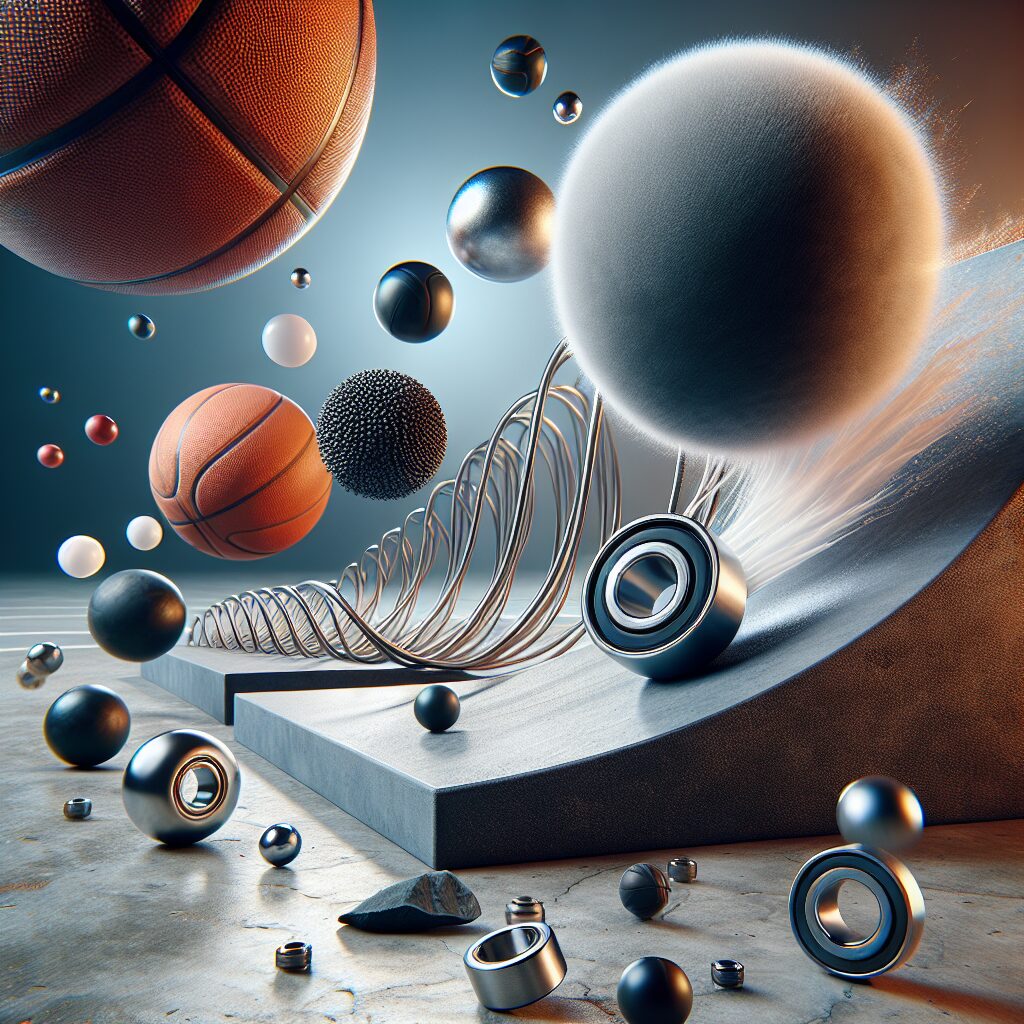Elasticity in Balls: Bouncing to Perfection
Elasticity is an essential characteristic that makes balls bounce with perfection. When you think of a bouncing ball, you might envision its ability to rebound effortlessly off a surface. This mesmerizing behavior is due to the elasticity of the ball. Elasticity refers to the property of an object to regain its original shape when subjected to a force. In the context of balls, elasticity allows them to compress upon impact and then quickly spring back to their original form, resulting in a remarkable bouncing effect.
The impact of elasticity on the performance of balls is quite remarkable. One key impact is the efficiency of their bouncing ability. The more elastic a ball is, the higher it can bounce. This property is especially crucial in sports such as basketball, tennis, and golf, where the height of the ball’s bounce greatly affects the game’s dynamics. Additionally, the elasticity of balls also influences their durability. By being able to absorb and store energy during impact, elastic balls can withstand repeated use without deforming or losing their bouncing capabilities.
Now that we’ve delved into the fascinating world of elasticity in balls, let’s explore some key takeaways regarding this topic. In the following sections, we will discuss the factors affecting the elasticity of balls, the materials used to enhance their bounce, and the role of elasticity in different sports. By understanding these aspects, you’ll gain a deeper appreciation for the science behind bouncing balls and discover the secrets that make them bounce to perfection. So, without further ado, let’s dive into the exciting world of elasticity in balls and unravel the mysteries behind their bouncing prowess.
Key Takeaways
1. Elasticity is a crucial factor in determining a ball’s performance, and it is influenced by various factors such as the material used and the way the ball is made.
2. The coefficient of restitution (COR) is a measure of a ball’s bounciness, and it determines how much kinetic energy is lost when a ball collides with another surface.
3. Balls made of different materials exhibit different levels of elasticity and bounce, with natural rubber and synthetic polymers being commonly used materials for producing elastic balls.
4. Manufacturers can control the elasticity of balls by adjusting factors like the components used in the material, the manufacturing process, and the temperature at which the ball is created.
5. The understanding and manipulation of ball elasticity are crucial for industries such as sports equipment manufacturing and developing new materials for a variety of applications. By studying the science behind elasticity, researchers aim to maximize performance and optimize the bounce of balls.
What Makes Elasticity in Balls Perfect for Bouncing?
Elasticity in balls is a crucial factor when it comes to achieving the perfect bounce. Whether it’s for sports, games, or even science experiments, understanding the science behind ball elasticity can help us maximize the performance and enjoyment of these objects. In this article, we will delve deep into the world of elasticity in balls and explore various aspects that contribute to achieving the ultimate bounce.
1. Materials and Construction
The materials used in the production of balls play a significant role in determining their elasticity. Common materials include rubber, synthetic compounds, and even natural fibers. The construction of the ball, such as the design and layering, also affects its elasticity. Manufacturers carefully select these elements to ensure the ball can withstand the forces applied during bouncing while maintaining optimal elasticity.
2. Elasticity and Ball Design
Ball design is a critical factor in achieving a perfect bounce. The shape, size, and surface texture impact how the ball interacts with the ground or other surfaces. Balls with round shapes and smooth surfaces tend to exhibit better elasticity, resulting in higher and more consistent bounces. The distribution of weight within the ball also influences its elasticity and ensures a predictable trajectory upon impact.
3. Factors Affecting Elasticity
Several factors affect the elasticity of balls, including temperature, air pressure, and wear and tear. In colder temperatures, the elasticity of certain materials may decrease, leading to reduced bounce heights. Air pressure within the ball also affects its elasticity, with overinflated or underinflated balls experiencing changes in bounce characteristics. Additionally, regular use and exposure to external factors can cause wear and tear, gradually reducing a ball’s elasticity over time.
4. Measuring Elasticity
Scientists and manufacturers use various methods to measure the elasticity of balls accurately. One common measurement is the coefficient of restitution (COR), which represents the ratio of the final velocity to the initial velocity after a bounce. The higher the COR, the greater the elasticity. This measurement enables comparison between different ball types and provides insights into their bounce performance.
5. Applications of Elasticity in Balls
The concept of elasticity in balls goes beyond simple playtime. Engineers and scientists utilize ball elasticity principles to design advanced equipment for various fields. It is extensively employed in sports like tennis, basketball, and golf to optimize performance and enhance player experience. Furthermore, understanding ball elasticity aids in developing specialized balls for scientific experiments, such as physics demonstrations and studies on energy transfer.
6. Tips for Maximizing Ball Elasticity
- Keep balls clean and free from debris to minimize wear and tear.
- Maintain proper air pressure within the balls according to manufacturer guidelines.
- Store balls in a controlled environment to prevent exposure to extreme temperatures.
- Regularly inspect balls for signs of damage or deterioration and replace as necessary.
- Use appropriate balls for specific activities to ensure optimal bounce performance.
- Consider using specialized cleaning agents or techniques recommended by the manufacturer to restore elasticity.
Frequently Asked Questions
1. What is elasticity in balls?
Elasticity in balls refers to the property of a ball to deform under external force and then regain its original shape when the force is removed. It determines the ball’s ability to bounce back after being dropped or hit.
2. Why is elasticity important in balls?
Elasticity is crucial in balls as it directly affects their bouncing characteristics. A ball with high elasticity will bounce back higher and with more energy, enabling better performance in various sports and games.
3. How is the elasticity of balls measured?
The elasticity of balls is typically measured using a coefficient called the coefficient of restitution (COR). It quantifies the relationship between the incoming velocity and the outgoing velocity of the ball after a collision, providing a measure of its elasticity.
4. What factors affect the elasticity of balls?
Several factors influence the elasticity of balls, including the materials used, their composition, surface texture, and internal pressure. Balls made of highly elastic materials like rubber or certain polymers tend to exhibit greater bounce.
5. Can the elasticity of a ball be improved?
Depending on the materials and manufacturing processes involved, it is possible to enhance the elasticity of a ball. By using specific materials, modifying the ball’s internal structure, or altering surface characteristics, manufacturers can optimize its bounce and overall performance.
6. Are all balls equally elastic?
No, different types of balls have varying levels of elasticity. For example, a basketball usually has a higher elasticity than a golf ball due to differences in materials and design. The purpose and intended use of the ball also play a role in determining its elasticity.
7. Can elasticity in balls be reduced over time?
Yes, the elasticity of balls can decrease over time due to use, exposure to environmental conditions, and aging of the materials. It is important to properly maintain and store balls to minimize this degradation and ensure consistent bounce performance.
8. How does elasticity affect ball control in sports?
Elasticity greatly influences ball control in sports such as tennis, soccer, or billiards. A ball with optimal elasticity allows players to have better precision, accuracy, and predictability in their movements, enabling them to execute desired plays and strategies more effectively.
9. Can the elasticity of balls be adjusted?
In some cases, the elasticity of balls can be adjusted by changing the internal pressure or modifying the materials. This is often done to optimize performance for specific sports, ensuring a good balance between bounce height, energy transfer, and desired characteristics.
10. Are there any safety concerns related to highly elastic balls?
While highly elastic balls can provide exciting gameplay and performance, there may be safety concerns regarding their rebound speed. It is essential to use appropriate balls for each activity to prevent potential accidents or injuries caused by excessive bounce.
Final Thoughts on Elasticity in Balls: Bouncing to Perfection
Elasticity plays a fundamental role in the performance and enjoyment of various sports and recreational activities. Understanding the principles of elasticity in balls allows us to appreciate the precision engineering involved and the careful consideration put into creating the perfect bounce.
Whether you’re a professional athlete, an enthusiastic hobbyist, or simply enjoying a casual game, the elasticity of balls can make a significant difference in your experience. So, next time you pick up a ball, take a moment to appreciate the science behind its elasticity and the joy it brings to the game.




